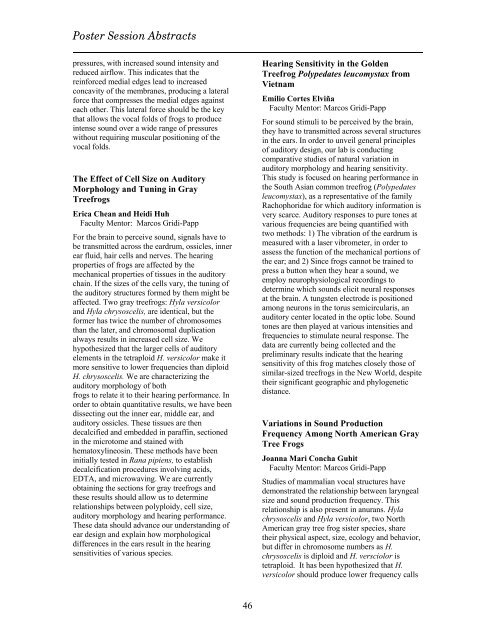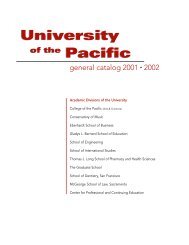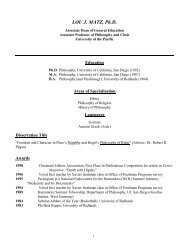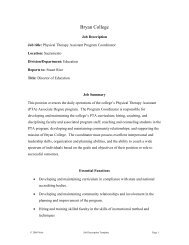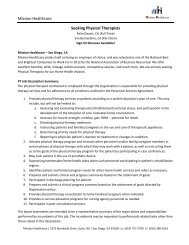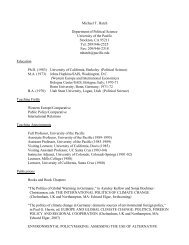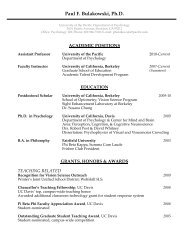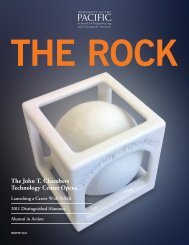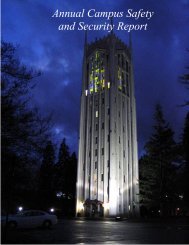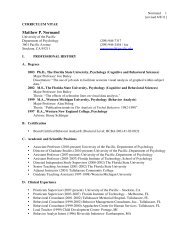purcc 2012 - University of the Pacific
purcc 2012 - University of the Pacific
purcc 2012 - University of the Pacific
You also want an ePaper? Increase the reach of your titles
YUMPU automatically turns print PDFs into web optimized ePapers that Google loves.
Poster Session Abstracts<br />
pressures, with increased sound intensity and<br />
reduced airflow. This indicates that <strong>the</strong><br />
reinforced medial edges lead to increased<br />
concavity <strong>of</strong> <strong>the</strong> membranes, producing a lateral<br />
force that compresses <strong>the</strong> medial edges against<br />
each o<strong>the</strong>r. This lateral force should be <strong>the</strong> key<br />
that allows <strong>the</strong> vocal folds <strong>of</strong> frogs to produce<br />
intense sound over a wide range <strong>of</strong> pressures<br />
without requiring muscular positioning <strong>of</strong> <strong>the</strong><br />
vocal folds.<br />
The Effect <strong>of</strong> Cell Size on Auditory<br />
Morphology and Tuning in Gray<br />
Treefrogs<br />
Erica Chean and Heidi Huh<br />
Faculty Mentor: Marcos Gridi-Papp<br />
For <strong>the</strong> brain to perceive sound, signals have to<br />
be transmitted across <strong>the</strong> eardrum, ossicles, inner<br />
ear fluid, hair cells and nerves. The hearing<br />
properties <strong>of</strong> frogs are affected by <strong>the</strong><br />
mechanical properties <strong>of</strong> tissues in <strong>the</strong> auditory<br />
chain. If <strong>the</strong> sizes <strong>of</strong> <strong>the</strong> cells vary, <strong>the</strong> tuning <strong>of</strong><br />
<strong>the</strong> auditory structures formed by <strong>the</strong>m might be<br />
affected. Two gray treefrogs: Hyla versicolor<br />
and Hyla chrysoscelis, are identical, but <strong>the</strong><br />
former has twice <strong>the</strong> number <strong>of</strong> chromosomes<br />
than <strong>the</strong> later, and chromosomal duplication<br />
always results in increased cell size. We<br />
hypo<strong>the</strong>sized that <strong>the</strong> larger cells <strong>of</strong> auditory<br />
elements in <strong>the</strong> tetraploid H. versicolor make it<br />
more sensitive to lower frequencies than diploid<br />
H. chrysoscelis. We are characterizing <strong>the</strong><br />
auditory morphology <strong>of</strong> both<br />
frogs to relate it to <strong>the</strong>ir hearing performance. In<br />
order to obtain quantitative results, we have been<br />
dissecting out <strong>the</strong> inner ear, middle ear, and<br />
auditory ossicles. These tissues are <strong>the</strong>n<br />
decalcified and embedded in paraffin, sectioned<br />
in <strong>the</strong> microtome and stained with<br />
hematoxylineosin. These methods have been<br />
initially tested in Rana pipiens, to establish<br />
decalcification procedures involving acids,<br />
EDTA, and microwaving. We are currently<br />
obtaining <strong>the</strong> sections for gray treefrogs and<br />
<strong>the</strong>se results should allow us to determine<br />
relationships between polyploidy, cell size,<br />
auditory morphology and hearing performance.<br />
These data should advance our understanding <strong>of</strong><br />
ear design and explain how morphological<br />
differences in <strong>the</strong> ears result in <strong>the</strong> hearing<br />
sensitivities <strong>of</strong> various species.<br />
Hearing Sensitivity in <strong>the</strong> Golden<br />
Treefrog Polypedates leucomystax from<br />
Vietnam<br />
Emilio Cortes Elviña<br />
Faculty Mentor: Marcos Gridi-Papp<br />
For sound stimuli to be perceived by <strong>the</strong> brain,<br />
<strong>the</strong>y have to transmitted across several structures<br />
in <strong>the</strong> ears. In order to unveil general principles<br />
<strong>of</strong> auditory design, our lab is conducting<br />
comparative studies <strong>of</strong> natural variation in<br />
auditory morphology and hearing sensitivity.<br />
This study is focused on hearing performance in<br />
<strong>the</strong> South Asian common treefrog (Polypedates<br />
leucomystax), as a representative <strong>of</strong> <strong>the</strong> family<br />
Rachophoridae for which auditory information is<br />
very scarce. Auditory responses to pure tones at<br />
various frequencies are being quantified with<br />
two methods: 1) The vibration <strong>of</strong> <strong>the</strong> eardrum is<br />
measured with a laser vibrometer, in order to<br />
assess <strong>the</strong> function <strong>of</strong> <strong>the</strong> mechanical portions <strong>of</strong><br />
<strong>the</strong> ear; and 2) Since frogs cannot be trained to<br />
press a button when <strong>the</strong>y hear a sound, we<br />
employ neurophysiological recordings to<br />
determine which sounds elicit neural responses<br />
at <strong>the</strong> brain. A tungsten electrode is positioned<br />
among neurons in <strong>the</strong> torus semicircularis, an<br />
auditory center located in <strong>the</strong> optic lobe. Sound<br />
tones are <strong>the</strong>n played at various intensities and<br />
frequencies to stimulate neural response. The<br />
data are currently being collected and <strong>the</strong><br />
preliminary results indicate that <strong>the</strong> hearing<br />
sensitivity <strong>of</strong> this frog matches closely those <strong>of</strong><br />
similar-sized treefrogs in <strong>the</strong> New World, despite<br />
<strong>the</strong>ir significant geographic and phylogenetic<br />
distance.<br />
Variations in Sound Production<br />
Frequency Among North American Gray<br />
Tree Frogs<br />
Joanna Mari Concha Guhit<br />
Faculty Mentor: Marcos Gridi-Papp<br />
Studies <strong>of</strong> mammalian vocal structures have<br />
demonstrated <strong>the</strong> relationship between laryngeal<br />
size and sound production frequency. This<br />
relationship is also present in anurans. Hyla<br />
chrysoscelis and Hyla versicolor, two North<br />
American gray tree frog sister species, share<br />
<strong>the</strong>ir physical aspect, size, ecology and behavior,<br />
but differ in chromosome numbers as H.<br />
chrysoscelis is diploid and H. versciolor is<br />
tetraploid. It has been hypo<strong>the</strong>sized that H.<br />
versicolor should produce lower frequency calls<br />
46


